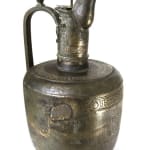Islamic Bronze Water Jug, 12 CE - 14 CE
Bronze
14.5
FZ.394
The art of metalwork has been one of the principal forms of artistic expression in the Islamic world. Responding to the taste and needs of different social and economic classes,...
The art of metalwork has been one of the principal forms of artistic expression in the Islamic world. Responding to the taste and needs of different social and economic classes, artists continuously explored the technical and decorative potential of their materials to transform simple, functional objects into highly refined works of art.
In the late tenth century, metalworkers in eastern Iran began to manufacture brass and bronze objects inlaid with designs in gold, silver, and copper. This technique allowed metalworkers "to paint" their vessels with scenes of hunting and feasting—associated with courtly life—astrological signs, and bold calligraphic dedications to rulers. Although the art of inlay was already known in West Asia since at least the sixth century, it reached new levels of artistic and technical sophistication after the arrival of Islam. These vessels are among some of the most powerful expressions of the social, political, and cultural life and aspiration of the individuals and societies for which they were created.
Originally, the engraved decorations incised onto the exterior of this bronze vessel would have been inlaid with silver or gold. This precious adornment would have made this jug even that much more resplendent. Surely this splendid vessel once proudly stood in the center of a table during sumptuous banquets and hearty feasts. While serving a most basic function, this jug is simultaneously a stunning work of art treasured for its elegance and detailed engravings. A band of cufic text has been inscribed along the shoulder of the vessel, perhaps a dedicatory passage to the owner or a poetical or religious verse in honor of gastronomic pursuits. This container is a reminder of an earlier age when beauty was prized over function. Today, a simple mass-produced plastic pitcher would stand in place of this jug, lacking any individual charm or unique beauty. However, today this jug is treasured for its form alone, for its resplendent artistry and timeless elegance.
. FZ.394. Ewer with high spout, cast bronze with engraved and copper inlaid decoration. Cylindrical upward opening body, resting on a raised base, sloping shoulder with a flat top, cylindrical neck terminating in an everted flat rim and with a rising high spout imitating a bird’s head. Plain handle with a large thumb-piece on top. There is an epigraphic band in thuluth style on the body below the spout inlaid in copper and with a roundel at both ends; below this band is a lobed cartouce with simple scroll design, while to the right and left a vase-shaped design with emerging flowers. The flat top of the shoulder carries a pseudo-epigraphic band; simple engraved designs on the neck and the spout.
Afghanistan, probably Ghazni, 11th century. Comparative material: Eva Baer, “Wider Aspects of Some Ghaznavid Bronzes”, Rivista degli Studi Orientali, vol.LIX, 1987, pp.1-15; Géza Fehérvári, „High spouted Ewers of Khorasan and Central Asia” , Journal of Inner Asian Art and Archaeology, vol. 1, 2006, pp.157-62.
Prof. Geza Fehervar Prof. Geoffrey Kin
In the late tenth century, metalworkers in eastern Iran began to manufacture brass and bronze objects inlaid with designs in gold, silver, and copper. This technique allowed metalworkers "to paint" their vessels with scenes of hunting and feasting—associated with courtly life—astrological signs, and bold calligraphic dedications to rulers. Although the art of inlay was already known in West Asia since at least the sixth century, it reached new levels of artistic and technical sophistication after the arrival of Islam. These vessels are among some of the most powerful expressions of the social, political, and cultural life and aspiration of the individuals and societies for which they were created.
Originally, the engraved decorations incised onto the exterior of this bronze vessel would have been inlaid with silver or gold. This precious adornment would have made this jug even that much more resplendent. Surely this splendid vessel once proudly stood in the center of a table during sumptuous banquets and hearty feasts. While serving a most basic function, this jug is simultaneously a stunning work of art treasured for its elegance and detailed engravings. A band of cufic text has been inscribed along the shoulder of the vessel, perhaps a dedicatory passage to the owner or a poetical or religious verse in honor of gastronomic pursuits. This container is a reminder of an earlier age when beauty was prized over function. Today, a simple mass-produced plastic pitcher would stand in place of this jug, lacking any individual charm or unique beauty. However, today this jug is treasured for its form alone, for its resplendent artistry and timeless elegance.
. FZ.394. Ewer with high spout, cast bronze with engraved and copper inlaid decoration. Cylindrical upward opening body, resting on a raised base, sloping shoulder with a flat top, cylindrical neck terminating in an everted flat rim and with a rising high spout imitating a bird’s head. Plain handle with a large thumb-piece on top. There is an epigraphic band in thuluth style on the body below the spout inlaid in copper and with a roundel at both ends; below this band is a lobed cartouce with simple scroll design, while to the right and left a vase-shaped design with emerging flowers. The flat top of the shoulder carries a pseudo-epigraphic band; simple engraved designs on the neck and the spout.
Afghanistan, probably Ghazni, 11th century. Comparative material: Eva Baer, “Wider Aspects of Some Ghaznavid Bronzes”, Rivista degli Studi Orientali, vol.LIX, 1987, pp.1-15; Géza Fehérvári, „High spouted Ewers of Khorasan and Central Asia” , Journal of Inner Asian Art and Archaeology, vol. 1, 2006, pp.157-62.
Prof. Geza Fehervar Prof. Geoffrey Kin



